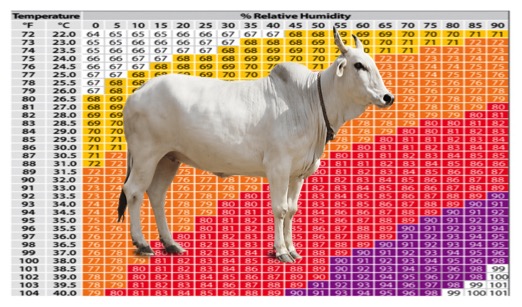Summers in India are getting hotter and 2024 will be no different. The Indian Meteorological Department’s (IMD) forecast for 2024 indicates that India will face a harsh summer with longer than usual heat waves. Last year was the 2nd hottest year for India (2016 being the hottest) in the last 122 years, exposing humans, animals and plant life to increasing heat stress.
Experts opine that the trend of rising temperatures, with more frequent, intense, and prolonged heatwaves will exacerbate in future, as the temperature could rise ±1.2° to ±3.5° C by the end of 2050.
Rising temperature and cycle of prolonged heat waves are already triggering water scarcity, increasing instances of pest and disease attacks, lowering farm productivity, and consequently, leading to food price inflation. While impacts of climate crisis on agriculture are well studied and reported, the impacts of the crisis on India’s livestock sector remain under-researched.Heat stress in cattle and buffaloes caused by increasing temperature and humidity impacts their health, wellbeing, and production capacity. We are mid-way through the summer and dairy companies are reporting a decrease in the milk supply.
A report in Lancet forecasts that the rising temperature in India threatens to reduce milk production by 25% by 2085. India being the largest milk producer and consumer of the world, these production losses will put the livelihoods and nutrition of millions at risk, especially to the 89 million small holder dairy farmers that contributes 85% of the total milk production.
Dairy experts use a scientific method – Temperature Humidity Index (THI) to evaluate the impact of heat stress on cattle and buffaloes. This index measures the thermal comfort of the animal. An index value up to 72 is optimal for milk production, and for each THI value increase beyond 72, the milk production level in cattle starts declining by 200 grams per day.
A study conducted in the northern plains of India (region that accounts for 30% of India’s milk production), THI level crosses 80 and beyond, during summers. For more than half the year (April to October), dairy cattle suffer from heat stress. Animals find little respite since temperatures don’t cool fast enough in the night either. If these conditions continue unabated, heat stress induced production losses in the northern plains are estimated to reach ~3.4 lakh tons of milk by 2030. Dairy farmers will lose approximately 15,000 crores as their cattle produce less milk and will suffer with heat induced heath issues.
Recognising the challenge of heat stress induced production losses, the Government of India launched programs in 2017 to identify traits for heat tolerance and develop climate resilient dairy practices. The National Bureau of Animal Genetic Record (NBAGR) has identified 3 major heat tolerance traits in cattle—heat shock proteins, coat colour and woolly hair.
Research has shown, indigenous cattle, and among them Sahiwal breed, have better heat tolerance capacity than the exotic cattle. However, these resilient traits are not always prioritised in animal breeding programs. In a market of close margins, farmers prefer raising animals that can produce more milk over animals that are sturdier but produce less milk. To help balance the trade-offs between producing more milk and ensuring a healthier dairy herd, animal breeding programs need to equally integrate performance traits like milk production as well as for heat tolerance traits, so that farmers can raise productive and healthy cattle.



























